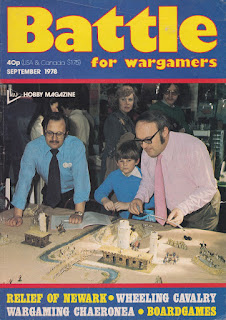The now departed author and hobby personality playing a colonial game in 1978. No hiding the width of neckties from that era!
Another one of the hobby greats, Stuart Asquith, passed away during the weekend. While we never met (I am on the wrong side of the Atlantic), I was fortunate enough to exchange a couple of short emails with him 10 or 12 years ago when he was involved with a blog about all things Charge!
Said blog was managed by four or five UK hobbyists during the wave of enthusiasm that followed the 2006 Sittangbad and 2007 Mollwitz refights at Partizan in the U.K. just as hobby and imagination blogging took off in a big way. Sadly, the blog disappeared pretty quickly, but it was a real blast interacting with Stu even if only briefly and in passing. He was very personable and humble in his emails to me, expressing surprise that a stranger in the U.S. had an inkling of who he was.
Stu Asquith's writing years ago in Military Modeling, various books, and magazines like Practical Wargamer and later Battlegames struck a chord with me in the same way that it probably did for many others in the hobby. His informed enthusiasm always seemed to leap from the page if I might put it that way. Oddly, I've been enjoying his thoughts on the 18th century once again these last few weeks via John Curry's reissue of Wargaming 18th Century Battles.
A more flattering photograph follows below from the December 1980 cover of Military Modelling, featuring Stu Asquith and colleague in striped rowing blazers and boater hats along with scads of plastic Britains figures on the table. A marvelous image to be sure!
It is indeed peculiar how, even when one has never actually met a personality and writer like Mr. Asquith, we nevertheless feel as though we knew them personally. I felt the same way when Donald Featherstone and Paddy Griffith left this mortal coil several years back, as well as the Norwegian author Stig Saetterbakken, some of whose work I translated into English once upon a time, along with a few articles about him, for some small publishing houses.
My guess for this very real connection we might feel is that their writing allows access to deep insight into their personalities, ideas, and even world views, which goes a long way toward establishing that connection -- a genuine meeting of the minds if you will -- even without ever becoming acquainted face to face and developing a friendship of longstanding. In any case, there is no doubt that Stuart Asquith touched the hobby lives of many of us wargamers around the globe via his articles, book titles, stints as a magazine editor, and wargame show activities over the years.
What I have always liked best about Mr. Asquith's approach to tabletop warfare was the relative simplicity of his rules regardless of the period in question. I think I read an article he wrote 35+ year ago, where he made the point that if rules were simple enough, players could get on with a game, concentrate on reproducing the tactics of a given era, and make it an interesting exercise themselves rather than depending on the writer of overly complex rules to attempt that for them. There is something to that attitude and approach I think.
Simplicity of approach has been something I try to emulate myself in the mid-18th century rules I've been tinkering with for the last couple of years here. Indeed, I've come up with a couple of great new very simple thoughts on handling tabletop troop morale just this week that build on, yet depart a bit from the old '50% Rule' without straying too far into numbers crunching. No fun there!
The modest ideas I describe owe just as much to Stu Asquith as to Don Featherstone. I hope the two men might be meeting for a tabletop encounter once again somewhere in the afterlife now since I believe the latter was an honorary member of Stu's Rayners Lane Wargame Club.
-- Stokes
Found it! Said cover photograph. A stirring picture if ever there were one. I have always had something similar in the back of my mind. But perhaps more in the context of August-September 1914 in East Prussia with 1/72 plastics? Now, there's a HUGE butterfly!


Comments
Not my period but I too have read his books & briefly got the "imaginations bug". His like may not be seen again I fear.
Best wishes,
Jeremy
Thank you for your kind words about my dad, Stuart Asquith. Reading comments like this is a great comfort to me and my family at this difficult time.
Kind regards,
Tom
Thank you for your kind words about my dad, Stuart Asquith. Reading comments like this is a great comfort to me and my family at this difficult time.
Kind regards,
Tom
Nor the fact that people wore one whilst wargaming
norton.com/setup
norton com setup download
norton setup